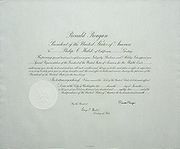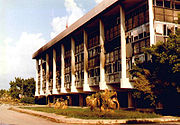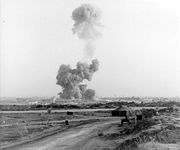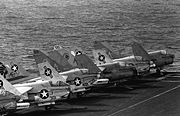
Multinational Force in Lebanon
Encyclopedia

Peacekeeping
Peacekeeping is an activity that aims to create the conditions for lasting peace. It is distinguished from both peacebuilding and peacemaking....
force created in 1982 and sent to Lebanon
Lebanon
Lebanon , officially the Republic of LebanonRepublic of Lebanon is the most common term used by Lebanese government agencies. The term Lebanese Republic, a literal translation of the official Arabic and French names that is not used in today's world. Arabic is the most common language spoken among...
to oversee the withdrawal of the Palestine Liberation Organization
Palestine Liberation Organization
The Palestine Liberation Organization is a political and paramilitary organization which was created in 1964. It is recognized as the "sole legitimate representative of the Palestinian people" by the United Nations and over 100 states with which it holds diplomatic relations, and has enjoyed...
. The participants included contingents of United States Marines
United States Marine Corps
The United States Marine Corps is a branch of the United States Armed Forces responsible for providing power projection from the sea, using the mobility of the United States Navy to deliver combined-arms task forces rapidly. It is one of seven uniformed services of the United States...
and Navy SEALs
United States Navy SEALs
The United States Navy's Sea, Air and Land Teams, commonly known as Navy SEALs, are the U.S. Navy's principal special operations force and a part of the Naval Special Warfare Command as well as the maritime component of the United States Special Operations Command.The acronym is derived from their...
, French
French Army
The French Army, officially the Armée de Terre , is the land-based and largest component of the French Armed Forces.As of 2010, the army employs 123,100 regulars, 18,350 part-time reservists and 7,700 Legionnaires. All soldiers are professionals, following the suspension of conscription, voted in...
paratrooper
Paratrooper
Paratroopers are soldiers trained in parachuting and generally operate as part of an airborne force.Paratroopers are used for tactical advantage as they can be inserted into the battlefield from the air, thereby allowing them to be positioned in areas not accessible by land...
s, Italian
Italy
Italy , officially the Italian Republic languages]] under the European Charter for Regional or Minority Languages. In each of these, Italy's official name is as follows:;;;;;;;;), is a unitary parliamentary republic in South-Central Europe. To the north it borders France, Switzerland, Austria and...
soldiers, and British
United Kingdom
The United Kingdom of Great Britain and Northern IrelandIn the United Kingdom and Dependencies, other languages have been officially recognised as legitimate autochthonous languages under the European Charter for Regional or Minority Languages...
soldiers.
Background


Lebanon crisis of 1958
The 1958 Lebanon crisis was a Lebanese political crisis caused by political and religious tensions in the country. It included a U.S. military intervention.-Background:...
. In that intervention, 14,000 Americans were sent to Lebanon by President Dwight D. Eisenhower
Dwight D. Eisenhower
Dwight David "Ike" Eisenhower was the 34th President of the United States, from 1953 until 1961. He was a five-star general in the United States Army...
to quell the opposition to President Camille Chamoun
Camille Chamoun
Camille Nimr Chamoun was President of Lebanon from 1952 to 1958, and one of the country's main Christian leaders during most of the Lebanese Civil War ....
and neighboring countries. The operation was considered a success.
In 1975, the Lebanese Civil War
Lebanese Civil War
The Lebanese Civil War was a multifaceted civil war in Lebanon. The war lasted from 1975 to 1990 and resulted in an estimated 150,000 to 230,000 civilian fatalities. Another one million people were wounded, and today approximately 350,000 people remain displaced. There was also a mass exodus of...
began. Further instability was caused in 1982 by the invasion of Lebanon
1982 Lebanon War
The 1982 Lebanon War , , called Operation Peace for Galilee by Israel, and later known in Israel as the Lebanon War and First Lebanon War, began on 6 June 1982, when the Israel Defense Forces invaded southern Lebanon...
by Israel
Israel
The State of Israel is a parliamentary republic located in the Middle East, along the eastern shore of the Mediterranean Sea...
, which targeted the Palestine Liberation Organization
Palestine Liberation Organization
The Palestine Liberation Organization is a political and paramilitary organization which was created in 1964. It is recognized as the "sole legitimate representative of the Palestinian people" by the United Nations and over 100 states with which it holds diplomatic relations, and has enjoyed...
(PLO) based there.
As the capital of Beirut
Beirut
Beirut is the capital and largest city of Lebanon, with a population ranging from 1 million to more than 2 million . Located on a peninsula at the midpoint of Lebanon's Mediterranean coastline, it serves as the country's largest and main seaport, and also forms the Beirut Metropolitan...
was besieged by the Israelis, U.S. Ambassador Philip Habib
Philip Habib
Philip Charles Habib was a Lebanese-American career diplomat known for work in Vietnam, South Korea and the Middle East...
negotiated with the warring parties for an end to the fighting and for the establishment of a peacekeeping force in Beirut. In August 1982, he was successful in bringing about an agreement for the evacuation of Syrian troops and PLO fighters from Beirut. The agreement also provided for the deployment of a three-nation Multinational Force (MNF) during the period of the evacuation.
Initial landing
The French troops landed in Beirut on August 21, with the U.S. troops (32nd Marine Amphibious Unit22nd Marine Expeditionary Unit
The 22nd Marine Expeditionary Unit is one of seven Marine Expeditionary Units currently in existence in the United States Marine Corps. The Marine Expeditionary Unit is a Marine Air Ground Task Force with a strength of about 2,200 personnel...
from Marine Corps Base Camp Lejeune
Marine Corps Base Camp Lejeune
Marine Corps Base Camp Lejeune is a United States military training facility in North Carolina. The base's of beaches make it a major area for amphibious assault training, and its location between two deep-water ports allows for fast deployments.The main base is supplemented by five satellite...
) arriving on August 24 and the Italians (2nd Bersaglieri "Governolo") on August 26. This initial force consisted of 850 Americans, 860 French, and 575 Italian troops. The PLO withdrew from Beirut to Tunisia
Tunisia
Tunisia , officially the Tunisian RepublicThe long name of Tunisia in other languages used in the country is: , is the northernmost country in Africa. It is a Maghreb country and is bordered by Algeria to the west, Libya to the southeast, and the Mediterranean Sea to the north and east. Its area...
on August 30; the foreign troops later withdrew to ships in the Mediterranean Sea
Mediterranean Sea
The Mediterranean Sea is a sea connected to the Atlantic Ocean surrounded by the Mediterranean region and almost completely enclosed by land: on the north by Anatolia and Europe, on the south by North Africa, and on the east by the Levant...
.
Increased involvement

Bachir Gemayel
Bachir Gemayel was a Lebanese politician, militia commander, and president-elect...
was assassinated. Then, from September 16–18, hundreds of Palestinian refugee
Palestinian refugee
Palestinian refugees or Palestine refugees are the people and their descendants, predominantly Palestinian Arabic-speakers, who fled or were expelled from their homes during and after the 1948 Palestine War, within that part of the British Mandate of Palestine, that after that war became the...
s were murdered by the Phalangist
Kataeb Party
The Lebanese Phalanges , better known in English as the Phalange , is a traditional right-wing Lebanese political party. Although it is officially secular, it is mainly supported by Maronite Christians. The party played a major role in the Lebanese War...
-led Lebanese Forces
Lebanese Forces
The Lebanese Forces is a Lebanese political party. Founded as a militia by Bachir Gemayel during the Lebanese Civil War, the movement fought as the main militia within the Christian-dominated Lebanese Front...
(LF) militia (who were allied with the Israeli Army
Israel Defense Forces
The Israel Defense Forces , commonly known in Israel by the Hebrew acronym Tzahal , are the military forces of the State of Israel. They consist of the ground forces, air force and navy. It is the sole military wing of the Israeli security forces, and has no civilian jurisdiction within Israel...
and had the presidency in Lebanon), backed by some elements of the also pro-Israeli South Lebanon Army
South Lebanon Army
The South Lebanon Army , also "South Lebanese Army," was a Lebanese militia during the Lebanese Civil War. After 1979, the militia operated in southern Lebanon under the authority of Saad Haddad's Government of Free Lebanon...
(SLA) in the Sabra and Shatila massacre
Sabra and Shatila massacre
The Sabra and Shatila massacre took place in the Sabra and Shatila Palestinian refugee camps in Beirut, Lebanon between September 16 and September 18, 1982, during the Lebanese civil war. Palestinian and Lebanese civilians were massacred in the camps by Christian Lebanese Phalangists while the camp...
s. This incident prompted U.S. President Ronald Reagan
Ronald Reagan
Ronald Wilson Reagan was the 40th President of the United States , the 33rd Governor of California and, prior to that, a radio, film and television actor....
to organize a new MNF with France and Italy. On September 29, this new force entered Beirut, with about 1,200 Marines. Their mission was to help the new Lebanese government and army with stability.
This new force consisted of 1,400 Marines (later increased to 1,800) of the 2nd Battalion, 8th Marine Regiment
2nd Battalion 8th Marines
2nd Battalion, 8th Marines is an infantry battalion in the United States Marine Corps based out of Marine Corps Base Camp Lejeune, North Carolina consisting of approximately 900 Marines and Sailors...
. They were relieved in place by the 3rd Battalion 8th Marines
3rd Battalion 8th Marines
3rd Battalion 8th Marines is an infantry battalion in the United States Marine Corps based out of Camp Lejeune, North Carolina consisting of approximately 1,100 Marines and Sailors...
in October 1982. The Battalion Landing Team's headquarters was based at Beirut International Airport. France's contingent of 1,500 paratrooper
Paratrooper
Paratroopers are soldiers trained in parachuting and generally operate as part of an airborne force.Paratroopers are used for tactical advantage as they can be inserted into the battlefield from the air, thereby allowing them to be positioned in areas not accessible by land...
s of the 8th Marine Infantry Parachute Regiment
8th Marine Infantry Parachute Regiment
The 8th Marine Infantry Parachute Regiment is an airborne regiment in the French Army. It is an elite unit that can be rapidly sent anywhere in the world...
(8 eme RPIMa) were based in West Beirut, and 1,400 Italian troops (paratroopers of the Folgore Brigade, Bersaglieri
Bersaglieri
The Bersaglieri are a corps of the Italian Army originally created by General Alessandro La Marmora on 18 June 1836 to serve in the Piedmontese Army, later to become the Royal Italian Army...
regiments and Marines of the San Marco Battalion
San Marco Regiment
The San Marco Regiment , located in Brindisi, are the marines of the Italian Navy. Until the middle of the 1990s the unit was known as the “San Marco Battalion” , until it was expanded beyond battalion size because of the new geopolitical situation after the end of the Cold War and an increasing...
) were based in the area between West Beirut and the airport. In February 1983, British
United Kingdom
The United Kingdom of Great Britain and Northern IrelandIn the United Kingdom and Dependencies, other languages have been officially recognised as legitimate autochthonous languages under the European Charter for Regional or Minority Languages...
troops (armored cars from 1st The Queen's Dragoon Guards
1st The Queen's Dragoon Guards
1st The Queen's Dragoon Guards is a cavalry regiment of the British Army. Nicknamed The Welsh Cavalry, the regiment recruits from Wales, Herefordshire, and Shropshire, and is the senior cavalry regiment, and therefore senior regiment, of the line of the British Army...
) joined the MNF.
During the winter of 1982-1983, the MNF was successful in its mission. Though officially neutral
Neutral country
A neutral power in a particular war is a sovereign state which declares itself to be neutral towards the belligerents. A non-belligerent state does not need to be neutral. The rights and duties of a neutral power are defined in Sections 5 and 13 of the Hague Convention of 1907...
, the force was responsible for preventing attacks from various Lebanese factions and the Israeli Army
Israel Defense Forces
The Israel Defense Forces , commonly known in Israel by the Hebrew acronym Tzahal , are the military forces of the State of Israel. They consist of the ground forces, air force and navy. It is the sole military wing of the Israeli security forces, and has no civilian jurisdiction within Israel...
. The MNF increasingly came under fire from factions of the Lebanese Civil War.
On April 18, 1983, the U.S. embassy in West Beirut was bombed
1983 United States Embassy bombing
The 1983 U.S. embassy bombing was a suicide bombing against the United States embassy in Beirut, Lebanon on April 18, 1983 that killed over 60 people, mostly embassy staff members and United States Marines and sailors. It was the deadliest attack on a U.S. diplomatic mission up to that time, and is...
, killing 63 people. This blast was a clear sign of opposition to the MNF.
The Israeli Army agreed on May 17, 1983 to withdraw from Beirut. In late 1983 U.S. Marines at the airport were repeatedly shelled by members of Shiite Muslim and Druze militia
Progressive Socialist Party
The Progressive Socialist Party or PSP , also known as Parti Socialiste Progressiste in French, is a political party in Lebanon. Its current leader is Walid Jumblatt...
s. Several Marines were killed and others wounded. In response, the U.S. warships , , , , and shelled Shiite and Druze positions near Beirut.
Barracks bombing

Later confrontations and withdrawal

French Navy
The French Navy, officially the Marine nationale and often called La Royale is the maritime arm of the French military. It includes a full range of fighting vessels, from patrol boats to a nuclear powered aircraft carrier and 10 nuclear-powered submarines, four of which are capable of launching...
warplanes retaliated to the barracks bombings by striking Iranian Revolutionary Guard in the Beqaa Valley
Beqaa Valley
The Beqaa Valley is a fertile valley in east Lebanon. For the Romans, the Beqaa Valley was a major agricultural source, and today it remains Lebanon’s most important farming region...
in November. At this time, tensions rose between Syria
Syria
Syria , officially the Syrian Arab Republic , is a country in Western Asia, bordering Lebanon and the Mediterranean Sea to the West, Turkey to the north, Iraq to the east, Jordan to the south, and Israel to the southwest....
and the United States as Syrian anti-aircraft batteries fired on U.S. aircraft as they patrolled Lebanese airspace. This culminated in the first direct U.S. military involvement in Lebanon on December 4. After being fired upon by Syrian missiles, U.S. aircraft targeted Syrian missile batteries in the mountains east of Beirut. In the process, Syrian 9K31 Strela-1 surface-to-air missiles shot down two American planes, an A-6 Intruder
A-6 Intruder
The Grumman A-6 Intruder was an American, twin jet-engine, mid-wing attack aircraft built by Grumman Aerospace. In service with the U.S. Navy and U.S. Marine Corps between 1963 and 1997, the Intruder was designed as an all-weather medium attack aircraft to replace the piston-engined A-1 Skyraider...
and an A-7 Corsair. The pilot of the A-6, Lieutenant Mark Lange (flying from USS John F. Kennedy), was killed; his Bombardier/Navigator, Lieutenant Bobby Goodman
Bobby Goodman
Robert O. Goodman is a former A-6 Intruder Bombardier Navigator and class of 1978 graduate of the United States Naval Academy. He was shot down over Lebanon on December 4, 1983. Captured upon ejection from his stricken plane, he was held captive for 30 days...
, ejected and was captured by Syrian soldiers. Lt. Goodman was held for 30 days before his released was facilitated by Jesse Jackson
Jesse Jackson
Jesse Louis Jackson, Sr. is an African-American civil rights activist and Baptist minister. He was a candidate for the Democratic presidential nomination in 1984 and 1988 and served as shadow senator for the District of Columbia from 1991 to 1997. He was the founder of both entities that merged to...
. Lt. Lange's body was returned. From the A-7, the pilot ejected and was rescued, although he suffered severe injuries.
On the same day, eight U.S. Marines were killed when Syrian-backed militias shelled the airport observation post.

USS New Jersey (BB-62)
USS New Jersey , is an , and was the second ship of the United States Navy to be named in honor of the U.S. state of New Jersey. New Jersey earned more battle stars for combat actions than the other three completed Iowa-class battleships, and is the only U.S...
fired on Lebanon on December 14 and 15. Meanwhile, Yasser Arafat
Yasser Arafat
Mohammed Yasser Abdel Rahman Abdel Raouf Arafat al-Qudwa al-Husseini , popularly known as Yasser Arafat or by his kunya Abu Ammar , was a Palestinian leader and a Laureate of the Nobel Prize. He was Chairman of the Palestine Liberation Organization , President of the Palestinian National Authority...
and his PLO left Tripoli
Tripoli, Lebanon
Tripoli is the largest city in northern Lebanon and the second-largest city in Lebanon. Situated 85 km north of the capital Beirut, Tripoli is the capital of the North Governorate and the Tripoli District. Geographically located on the east of the Mediterranean, the city's history dates back...
on December 20 on five Greek
Greece
Greece , officially the Hellenic Republic , and historically Hellas or the Republic of Greece in English, is a country in southeastern Europe....
ships bound for Tunisia
Tunisia
Tunisia , officially the Tunisian RepublicThe long name of Tunisia in other languages used in the country is: , is the northernmost country in Africa. It is a Maghreb country and is bordered by Algeria to the west, Libya to the southeast, and the Mediterranean Sea to the north and east. Its area...
. The MNF was targeted again by bombs on December 21, with a truck bomb killing a French soldier and 14 Lebanese outside a French military base, and a bomb killing four at a Western-owned bar.
The captured American crewman, Lt. Bobby Goodman, was released January 3, 1984, after negotiations with Reverend Jesse Jackson
Jesse Jackson
Jesse Louis Jackson, Sr. is an African-American civil rights activist and Baptist minister. He was a candidate for the Democratic presidential nomination in 1984 and 1988 and served as shadow senator for the District of Columbia from 1991 to 1997. He was the founder of both entities that merged to...
. At the same time, U.S. President Ronald Reagan was pressured for a troop withdrawal from Lebanon by Congress. These calls were increased after the Lebanese PM and his cabinet resigned February 5. Shiite and Druze militiamen began fighting outside Beirut on February 6 and threw the capital into chaos. Reagan ordered the 1,700 Marines to begin withdrawing on February 7. The following day, February 8, the USS New Jersey was again called upon to fire its main battery, this time against Syrian and Druze positions in the Beqaa Valley. During this Naval Gunfire Support (NGFS) mission, the "Big J" fired 288 rounds of its 16" projectiles. Thirty rounds hit a Syrian command post, killing the general commanding Syrian forces in Lebanon, and several of his senior officers. The Italians pulled out on February 20; the Marines followed on February 26. The last French troops left on March 31.
Casualties
The United States lost 265 soldiers in Lebanon, all but nine in hostile incidents, and all but twenty-four in the barracks bombing. 159 were wounded. France lost 89 soldiers (58 of them in the barracks bombing) and the Italians lost two.See also
- Islamic Jihad OrganizationIslamic Jihad OrganizationThe Islamic Jihad Organization – IJO or Organisation du Jihad Islamique in French, but best known as ‘Islamic Jihad’ for short, was a fundamentalist Shia group known for its activities in the 1980s during the Lebanese Civil War...
- Lebanese Civil WarLebanese Civil WarThe Lebanese Civil War was a multifaceted civil war in Lebanon. The war lasted from 1975 to 1990 and resulted in an estimated 150,000 to 230,000 civilian fatalities. Another one million people were wounded, and today approximately 350,000 people remain displaced. There was also a mass exodus of...
- Lebanese ForcesLebanese ForcesThe Lebanese Forces is a Lebanese political party. Founded as a militia by Bachir Gemayel during the Lebanese Civil War, the movement fought as the main militia within the Christian-dominated Lebanese Front...
- South Lebanon ArmySouth Lebanon ArmyThe South Lebanon Army , also "South Lebanese Army," was a Lebanese militia during the Lebanese Civil War. After 1979, the militia operated in southern Lebanon under the authority of Saad Haddad's Government of Free Lebanon...
- United Nations Interim Force in Lebanon (UNIFIL)United Nations Interim Force in LebanonThe United Nations Interim Force in Lebanon, or UNIFIL, was created by the United Nations, with the adoption of Security Council Resolution 425 and 426 on 19 March 1978, to confirm Israeli withdrawal from Lebanon which Israel had invaded five days prior, restore international peace and security,...

